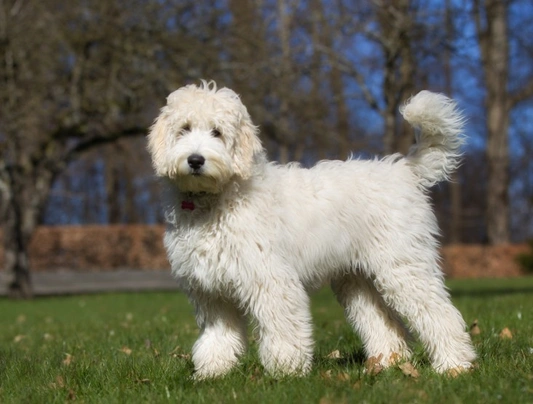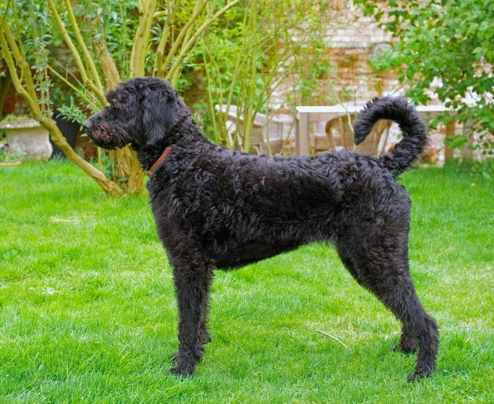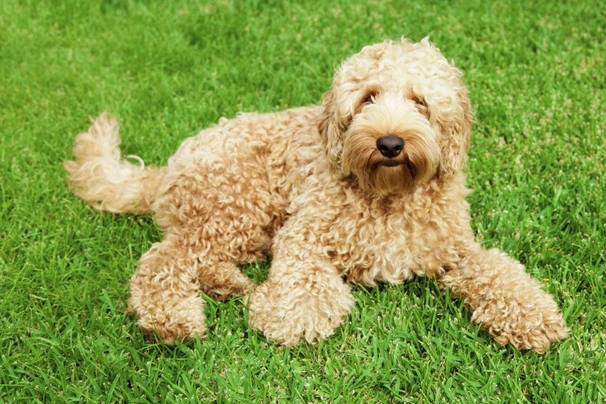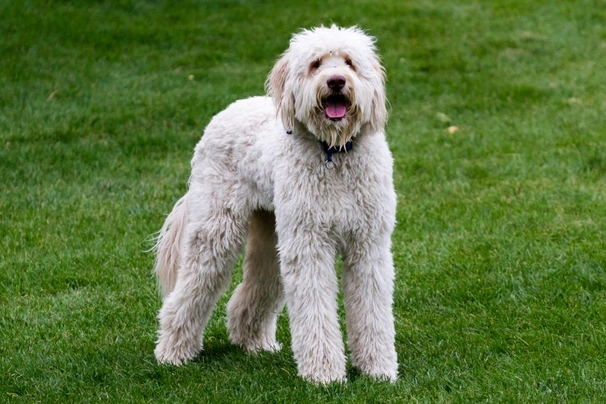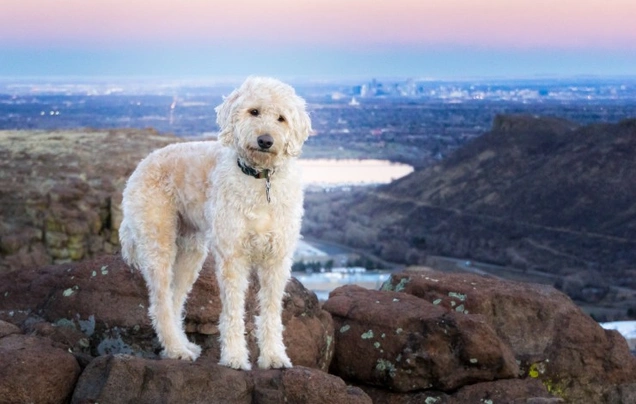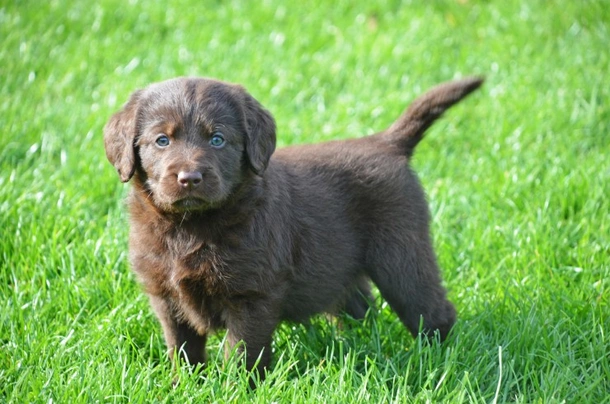Labradoodle
Pros
Cons
Introduction of the Labradoodle
The Labradoodle is the result of crossing a Labrador Retriever with either a Standard or Miniature Poodle and they first appeared on the scene back in the mid-1950's. They are high energy dogs with some of them having low shedding coats. As such they are often seen being used as assistance dogs for people who suffer from allergies. Labradoodles have become one of the most popular recent designer cross breeds to have appeared on the scene and for good reason because not only are they adorable looking but they are intelligent charming dogs that are a pleasure to have around too.
Labradoodles should not be described as "designer dogs" because they have been around for a long time and therefore they have become well-established in the world of working dogs having been bred to have a biddable nature. They should be thought of as a "cross breed" and one that has made their mark on the world and today the Labradoodle is among one of the most popular breeds in the UK.
History of the Labradoodle
Labradoodles were first bred to be assistance dogs and more especially for people who suffered from pet related allergies. It was in the 1980's that these dogs were first considered as being the perfect choice for a vision impaired lady who lived in Hawaii and whose husband had always suffered from allergies. The first puppy from a litter of three pups proved to have a hypoallergenic coat and so the name "Labradoodle" was given to the breed.
After this breeding centres were set up with an end goal being to create dogs with hypoallergenic coats and to establish consistency in a Labradoodle's breeding. The first litters to be born proved to have very low to no shedding coats whereas other litters from crosses between Poodles and Retrievers produced puppies that shed a lot more. However the results were positive enough for breeding programmes to continue after which time Labradoodles became a familiar sight in many homes throughout the world.
Although Guide Dogs Victoria the first organisation to breed Doodles no longer breeds them lots of other guide dog organisations now have breeding programmes in place. As such Labradoodles are still used all over the world as guide assistance and therapy dogs thanks to their naturally friendly outgoing and highly trainable personalities.
Labradoodles are not yet a Kennel Club recognised breed and as such no breed standard has been set. They can be the result of crossing a Labrador with a Poodle whether the father is a Lab or a Poodle or the mother is a Lab or a Poodle. They can also be the result of crossing two Labradoodles together or even by crossing a Labradoodle with a Poodle or a Labrador.
The Labradoodle Club in the UK (UKLA) believes that by not being Kennel Club registered allows for a healthier diversity in the Labradoodle's bloodlines while at the same time it allows less reputable breeders from taking advantage of the situation. As such all Labradoodle breeders can register their dogs and litters with the UKLA free of charge with an end goal being to maintain good breeding practices in Labradoodles.
Interesting facts about the breed
- Is the Labradoodle a vulnerable breed? They are among the most popular dogs not only in the UK but elsewhere in the world too thanks to their kind and biddable temperaments
- Labradoodles have proved themselves to be valuable and reliable therapy dogs thanks to their kind and biddable temperaments
- Labradoodles love being in and around water being true “water dogs” by nature
- They come in a variety of coat colours and textures depending on which of their parent breeds they have thrown to
- Labradoodles are very popular with celebrities
- They have very keen noses and therefore Labradoodles are brilliant trackers
Appearance of the Labradoodle
Height at the withers: Males 30 - 71 cm Females 30 - 71 cm
Average Weight: Males 10 - 40 kg Females 10 - 40 kg
Labradoodles come in a lot of sizes shapes and colours with 3 sizes being on the scene as well as multiple generations and around 8 different colours as well as 3 coat types to add to the mix. Although Doodles can look very different which includes puppies in the same litter they do tend to inherit their parent breed's traits both in physical looks and characteristics. However it really is luck of the draw as to how a puppy will turn out as it depends on which of the parent breeds a puppy throws to and it also depends on whether they are first second or third generation puppies.
Responsible breeders only use stud dogs that have been carefully screened for any hereditary or congenital health issues to reduce the chances of puppies developing any of the disorders their parent breeds are known to suffer from. However they also breed Doodles to have a certain type of coat and they always choose dogs that boast having kind affectionate and reliable natures.
Doodles generally have charming heads that seem larger thanks to all the loose hair that grows in abundance around their faces. They can be small medium or large sized dogs as there are 3 different sizes which are as follows:
- Standard – height: 53.34 – 60.96 cm - weight 22.67 – 29.48 kg
- Medium – height: 43.18 – 50.80 cm - weight 13.60 – 18.14 kg
- Miniature – height: 35.56 – 40.64 cm - weight 7.25 – 11.33 kg
All three sizes tend to be nicely proportioned and well-balanced dogs that boast having an athletic look about them while at the same time being graceful which is enhanced by their soft ringlet-type coat. They have moderately long muzzles and nice alert eyes which are covered in soft curls with Doodles often having quite a mischievous look about their eyes. Their ears are set well on a dog's head being well back and dropping forward which adds to a dog's endearing appeal. The Doodle has a strong jaw with a perfect scissor bite where their upper teeth neatly overlap their lower ones.
When it comes to their coat most Labradoodles have the following coat types:
- A long fleece coat that can be slightly wavy to extremely wavy with a lovely soft texture that hangs loosely in charming ringlets and which is low shedding
- A wool coat that consists of tight curls that's more reminiscent of the Poodle and which is considered hypoallergenic because dogs with this type of coat don’t shed
- A "hair coat" which first generation Doodles often have and which are more like the coat of the Labrador Retriever which means they tend to shed profusely throughout the year
A Doodle's coat can be various colours and colour combinations which are referred to as "parti or phantom". The most commonly seen colours are as follows:
- Red
- Black
- Blue
- Silver
- Caramel
- Chocolate
- Cafe
- Lavender
- Parchment
- Cream
- Apricot/gold
- Apricot/cream
- Chalk
Gait/movement
Labradoodles are nicely balanced dogs when they move which they do with free-moving albeit sometimes bouncy gait.
Faults
Any exaggeration whether it is a dog’s size or their conformation should be avoided at all costs for the welfare of a Labradoodle.
More about F1 F2 Labradoodle codes
Quite a few breeders use a code method to explain how they breed their puppies and which shows which cross generation their parent dogs happen to be. Although a good idea this method is not always that reliable. With this said a Labradoodle with an F1 code would be a first generation crossing and an F2 would be a second generation crossing and so forth but all potential owners should ask breeders about a puppy’s parent dogs and to see evidence of their “pedigree” which can be checked through the Kennel Club.
Temperament of the Labradoodle
Not only do well bred Labradoodles inherit many of their parent breed's adorable looks but they also inherit their intelligence and their friendly natures too. Doodles make such wonderful companions and family pets because of their intuitive and loving personalities which makes sharing a home with one of them such a pleasure whether they are first or multi-generation Doodles.
They are highly intelligent and love to please which means they are a great choice for first time owners providing they have all the time needed to dedicate to a high energy canine companion. Doodles need to be given a minimum of 2 hour's exercise a day and more if possible for them to be truly happy well-rounded obedient dogs. They also need to be given a ton of mental stimulation or boredom would soon set in which could see dogs finding new and innovative ways of amusing themselves. A bored Doodle could be quite destructive around the home.
They are a good choice for families where one person usually stays at home when everyone else is out of the house so they are never left to their own devices for too long at any given time. Because they love being in and around water Doodles do tend to get a bit mucky and as such they are not the best choice for anyone who is very house proud. It also means care has to be taken whenever a Doodle is allowed to run off their leads anywhere near more dangerous water courses just in case they decide to leap in.
Early socialisation is a must with Labradoodles and it should involve introducing them to lots of new situations noises people other animals and dogs once they have been fully vaccinated so they grow up to be more relaxed well balanced mature dogs. Their training must start as soon as a puppy arrives in their new home starting with the basics and then beginning their education in earnest when dogs have had all their jabs. Enrolling dogs into puppy classes is the best way to begin their training because not only does a puppy get to meet lots of other dogs and people but their training starts in a safe and controlled environment too.
It's important for Doodles to know their place in the pack and who they can look to for direction and guidance otherwise they may take on the role of alpha dog in a household which could see them showing a more dominant and undesirable side to their character. They are confident outgoing dogs by nature and this needs to be gently controlled right from the word go. If an owner allows a Doodle to get away with too much they can become unruly and wilful which makes dogs harder to handle and live with bearing in mind that Doodles are very smart and therefore just as quick to be mischievous and naughty as they are at being well-behaved and obedient.
Are they a good choice for first time owners?
Labradoodles are a great choice for first time dog owners because they are known to be so biddable by nature and being so intelligent they are easy to train too. The downside to their intelligence is that Labradoodles are just as quick to pick up bad habits as they are the good. As such their education must start early and it should be consistent throughout a dog's life so they understand their place in the pack and who they can look to for direction and guidance.
What about prey drive?
Labradoodles do not have a high prey drive and are very social by nature. However this does not mean they won't chase off the neighbour's cat if they ever get the chance to just for the fun of it. With this said Doodles must be taught the “leave it” and “heel” commands from a young age which is the best way of keeping them under control when they are off their leads.
What about playfulness?
Labradoodles love to please and enjoy playing interactive games with the people they love. They also excel at many canine sports and learn new things quickly thoroughly enjoying the one to one contact they are given when trained and when they are taking part in competitions whether it’s agility obedience or some other activity.
What about adaptability?
Labradoodles are known to be highly adaptable and providing they are given enough attention mental stimulation and daily exercise are just as happy living in town as they would in the country. With this said Labradoodles need to have enough space to express themselves as they should and enjoy nothing more than being to romp around in a secure back garden at every opportunity.
What about excessive barking?
Providing a Labradoodle is taught that barking for no reason is not acceptable when they are young they quickly understand the rules. However all dogs when left on their own for longer periods of time or are ignored will bark excessively to show they are unhappy about the situation and to get attention.
Do Labradoodles like water?
Most Labradoodles adore playing around in water and care should always be taken when walking them anywhere near more dangerous watercourses just in case a Labradoodle decides to leap in.
Are Labradoodles good watchdogs?
Labradoodles are not natural watchdogs but they would be quick to let an owner know when something they don't like is going on in their environment or when there are strangers about. However once a person has been introduced they would be a Labradoodles best friend.
Intelligence / Trainability of the Labradoodle
Labradoodles are highly intelligent dogs and they love to please enjoying nothing more than being around their owners and families. As such in the right hands and environment Doodles are easy to train and learn things extremely quickly. The downside to this is they are just as fast to learn bad habits and behaviours too which is why their training has to start early and it has to be consistent so dogs understand what is expected of them.
Labradoodles are the perfect candidates to work as Therapy Dogs and Assistance Dogs for the hard of hearing. They make wonderful Guide Dogs and are very good Seizure Alert Dogs too. In a home environment Doodles excel at all sorts of canine sports which includes activities like flyball agility and obedience trials.
They are sensitive by nature and as such they do not respond well to any sort of harsh correction or heavier handed training methods. They do answer very well to positive reinforcement which always brings the best out of these intelligent dogs. All too often a Doodle will outsmart their owner just for the fun of it.
A Doodle puppy should be taught the following commands as soon as they arrive in their new homes because it makes life easier for them simply because they understand the ground rules and limits which they might decide to test from time to time anyway:
- Come
- Sit
- Stay
- Quiet
- Leave it
- Down
- Bed
Children and other
Labradoodles are the perfect family pet thanks to the fact they are so gentle and affectionate around children of all ages. However playtime can get a bit boisterous which means any interaction between smaller children and a dog should always be well supervised by an adult to make sure nobody gets knocked over albeit by accident. Children should be taught when to leave a dog alone and when it is safe to play with them too.
Doodles generally get on well with other dogs and animals especially if they have been well socialised from a young enough age. If they grow up with a family cat in the home they usually get on well together but a Doodle would think nothing of chasing off any other cats they come across just for the fun of it. It’s always best to be careful when a Doodle is around smaller animals and pets just in case.
Health of the Labradoodle
The average life expectancy of a Labradoodle is between 12 and 15 years when properly cared for and fed an appropriate good quality diet to suit their ages.
The Labradoodle is such a new breed that more time is needed to know whether they are affected by any of the hereditary and congenital health issues that plague their parent breeds. With this said a Doodle may be more predisposed to the following health issues because their parent breeds are known to suffer from them and this includes the following health concerns for which all breeding dogs should be tested:
- Hip dysplasia - Breeders should have parent stud dogs hip scored
- Elbow dyspasia - Breeders should have parent stud dogs tested
- Progressive retinal atrophy - Breeders should have parent stud dogs eye tested
Other health disorders that are seen in both the Poodle and the Labrador which could affect the Labradoodle include the following:
- Cruciate ligament injuries
- Patellar luxation
- Cataracts
- Sebaceous adenitis
- Addison's disease
- Ear issues
What about vaccinations?
Labradoodle puppies would have had their first vaccinations but it's essential for them to have their follow-up jabs at the right time with the vaccination schedule being as follows:
- 10 -12 weeks old bearing in mind that a puppy would not have full protection straight away but would be fully protected 2 weeks after they have had their second vaccination
There has been a lot of discussion about the need for dogs to have boosters. As such it's best to talk to a vet before making a final decision on whether a Labradoodle should continue to have annual vaccinations which are known as boosters.
What about spaying and neutering?
A male Labradoodles can safely be neutered when they are 6 months old and females can be spayed when they are 6 months old too.
What about obesity problems?
Some Labradoodles gain weight after they have been neutered or spayed and it's important to keep a close eye on their calorie intake and the amount of daily exercise they get to prevent obesity. An obese Labradoodles would be put at risk of developing certain health issues which could end up shortening their lives by several years which can be as much as five years.
What about allergies?
A few Labradoodles can suffer from sensitive skin and therefore they are more prone to allergies which need to be diagnosed and treated sooner rather than later to make a dog more comfortable and to find out what might be triggering the allergy. The most common triggers can include the following:
- Environment
- A reaction to certain chemicals commonly found in household cleaning products
- Seasonal allergies which includes pollen and grasses
- Food which includes certain meats and cereals often used as ingredients in commercially produced dog food
- Tick and flea bites
- Dust mites
- Mould
Participating in health schemes
As previously mentioned all reputable Labradoodle breeders would have parent dogs hip scored and eye tested before using them for breeding purposes and would provide potential owners with the relevant documentation.
What about breed specific breeding restrictions?
Because the Labradoodle is not a Kennel Club recognised breed there are no breed specific breeding restrictions set in place for them.
What about Assured Breeder requirements?
There are no Kennel Club Assured Breeders for the Labradoodle.
Caring for the Labradoodle
As with any other breed Doodles need to be groomed on a regular basis to make sure their coats and skin are kept in top condition bearing in mind that some dogs are prone to suffering from specific skin allergies. They also need to be given regular daily exercise to ensure they remain fit and healthy. On top of this dogs need to be fed good quality food that meets all their nutritional needs throughout their lives.
Caring for a Labradoodle puppy
Labradoodle puppies whether they have thrown more to their Poodle of Labrador parent dog are always full of life and playful by nature. They are also highly intelligent even at such a young age and as such boundaries and ground rules must be put in place as soon as a puppy arrives in a new home which is the best way of ensuring they don't get too spoiled which could lead to a dog becoming wilful and unruly.
It's best to bring a new puppy home when it's known that someone is going to be around for the first week or so after their arrival. The reason being that all puppies feel a little bewildered and alone when they arrive in a new environment having just left their mothers and littermates. As such it's best to be around for them during their settling-in period which can make their transition that much easier for a young puppy to cope with.
Puppy-proofing a home and garden is essential which should include putting anything a puppy can injure themselves on well out of their reach. Electric wires and cables should be made secure to avoid a puppy from chewing on them which could end in them being injured or in a worst-case scenario electrocuted. Garden tools should be put away too to prevent a puppy from injuring themselves on anything when they romp around a garden. It's also a good idea to check flower beds to make sure there are not toxic plants growing in them and if there are to remove them before letting a puppy outside into the garden.
A Labradoodle puppy would have been wormed before being sold and the documentation a breeder provides for a puppy must have all the details of their worming date and the product used as well as the information relating to their microchip. It is essential for puppies to be wormed again keeping to a schedule which is as follows:
- Puppies should be wormed at 6 months old
- They need to be wormed again when they are 8 months old
- Puppies should be wormed when they are 10 months old
- They need to be wormed when they are 12 months old
Things you'll need for your puppy
There are items needed to care for a puppy which should be purchased well in advance of their arrival. The items needed include the following:
- Feed and water bowls making sure they are not too deep and ideally they should be ceramic rather than plastic or metal
- A good quality dog collar harness and lead
- A dog crate that's not too small or too big that a puppy would feel lost in it
- A well-made dog bed bearing in mind that a puppy could well chew on it
- Baby and/or dog blankets to use in the puppy's crate and dog bed
- Dog specific toothpaste and tooth brush
- Shampoo and conditioner specifically formulated for use on dogs
- Grooming equipment
Keeping the noise down
All puppies are very sensitive to loud noises so it is important to keep the volume of a television down and not to play music too loudly either because it could frighten a Labradoodle puppy and prevent them from napping as they should during the day.
Keeping vet appointments
Reputable breeders would always ensure their puppies vaccinated before they are sold but as previously mentioned it is up to their new owners to make sure they are given their follow-up shots at the right time which should be as follows:
- 10 -12 weeks old bearing in mind that a puppy would not have full protection straight away but would only be fully protected 2 weeks after they have had their second vaccination
When it comes to boosters it's best to discuss these with a vet because there is a lot of debate about whether a dog really needs them after a certain time. However if a dog ever needed to go into kennels their vaccinations would need to be
What about Labradoodle when they reach their golden years?
When Labradoodle reach their golden years they slow down in many ways and they might start showing their age with more grey hairs appearing on their faces and more especially around their muzzles. Apart from a change in their appearance a Labradoodle personality might change too and this includes on how quick they are to respond to a command or when their names are called. The reason for this is that many older dog's hearing is not as good as it once was. Other changes to watch out for in a Labradoodle when they reach their senior years include the following:
- Their vision might be impaired and their eyes seem cloudy
- Their teeth might not be as in good condition which means they may need dental work
- Older dogs tend to sleep more during the day and they get up more frequently at night which is often because their cognitive function is not as sharp as it was when they were young which means older dogs are more easily confused
- They tend to be less tolerant of loud noises and sounds
- Dogs when they are older can be a little fussier about their food so it's important to rethink their diet and to make sure they are getting all the nutrients they need to stay healthy
- An older dog's immune system often does not offer them the same protection against illness and infection which puts them more at risk of catching something and why they should see the vet more routinely
- An older Labradoodle might not be so keen to go out for a walk and more especially longer ones
- They muscle tone and body condition is not as good as when they were young
- Older dogs often suffer from joint problems which can then lead to arthritis so it's well worth investing in a comfy dog bed and ideally one that a Labradoodle finds easier to get out of
Grooming of the Labradoodle
A Labradoodles coat can be wavy curly or straighter much like the coat of a Labrador Retriever which means it really does depend on a dog's coat type as to how much grooming they need to keep things tidy and in good condition. However a twice weekly brush is essential to remove any debris from a dog's coat and to prevent any knots of forming in straighter coated Doodles. It's important to trim the hair around a dog's eyes when necessary and the same can be said of their paws when the hair gets too long between the toes.
Dogs with fleece coats benefit from being professionally clipped which makes keeping things tidier and in good condition that much easier in between visits to a grooming parlour. It's also important to check a dog's ears on a regular basis and to clean them when necessary. If too much wax builds up in a dog's ears it can lead to a painful infection which can be hard to clear up. In short prevention is often easier than cure when it comes to ear infections.
Grooming tools needed for a Labradoodle
Having the right grooming tools helps keep a Labradoodle's coat and skin in top condition. The tools needed to keep a dog's coat looking good are as follows:
- A grooming glove
- A slicker brush
- A bristle brush
- A fine toothed comb
- Nail clippers
- A pair of round ended scissors
- Dog specific shampoo and conditioner
Exercise of the Labradoodle
The Labradoodle is a high energy intelligent dog and as such they need to be given the right amount of daily exercise and mental stimulation for them to be truly happy well-rounded dogs. They need a minimum of 1 hour's exercise every day with as much off the lead time as possible. If they are not given the right amount of mental stimulation and exercise every day a Doodle would quickly get bored and could even begin to show some destructive behaviours around the home which is their way of relieving any stress they are feeling.
A shorter walk in the morning would be fine but a longer more interesting one in the afternoon is a must. These dogs also like to be able to roam around a back garden as often as possible so they can really let off steam. However the fencing must be extremely secure to keep these high energy dogs in because if they find a weakness in the fence they will soon escape out and get into all sorts of trouble.
With this said Doodle puppies should not be over exercised because their joints and bones are still growing. This includes not letting a dog jump up and down from furniture or going up or down the stairs. Too much pressure placed on their joints and spines at an early age could result in a dog developing serious problems later in their lives.
Feeding of the Labradoodle
If you get a Doodle puppy from a breeder they would give you a feeding schedule and it's important to stick to the same routine feeding the same puppy food to avoid any tummy upsets. You can change a puppy's diet but this needs to be done very gradually always making sure they don't develop any digestive upsets and if they do it's best to put them back on their original diet and to discuss things with the vet before attempting to change it again.
Older dogs are not known to be fussy eaters but this does not mean they can be fed a lower quality diet. It's best to feed a mature dog twice a day once in the morning and then again in the evening making sure it's good quality food that meets all their nutritional requirements. It's also important that dogs be given the right amount of exercise so they burn off any excess calories or they might gain too much weight which can lead to all sorts of health issues. Obesity can shorten a dog's life by several years so it's important to keep an eye on their waistline from the word go.
Feeding guide for a Labradoodle puppy
Once a puppy is settled into their new homes it is safe to change their diets but as previously touched upon it needs to be done gradually and carefully to avoid any tummy upsets. As a rough guide Labradoodle puppies can be fed the following amounts every day to ensure they are getting all the nutrients they need to grow and develop properly:
- 2 months old - 211g to 237g depending on a puppy's build
- 3 months old - 262g to 308g depending on a puppy's build
- 4 months old - 283g to 339g depending on a puppy's build
- 6 months old - 323g to 445g depending on a puppy's build
- 8 months old - 299g to 418g depending on a puppy's build
- 10 months old - 286g to 411g depending on a puppy's build
- 12 months old - 287g to 401g depending on a puppy's build
- 14 months old - 285g to 394g depending on a puppy's build
Feeding guide for a Labradoodle
As a rough guide an adult fully grown Labradoodle can be fed the following amounts every day to ensure they stay fit and healthy:
- Dogs weighing 10 kg can be fed 131g to 152g depending on activity
- Dogs weighing 20 kg can be fed 298g to 378g depending on activity
- Dogs weighing 40 kg can be fed 418g to 550g depending on activity
Labradoodle price
If you are looking to buy a Labradoodle you would need to pay anything from £600 to over £900 for a well-bred puppy. The cost of insuring a male 3-year-old Labradoodle in northern England would be £22.01 a month for basic cover but for a lifetime policy this would set you back £41.75 a month (quote as of July 2016). When insurance companies calculate a pet's premium they factor in several things which includes where you live in the UK a dog's age and whether they have been neutered or spayed among other things.
When it comes to food costs you need to buy the best quality food whether wet or dry making sure it suits the different stages of a dog’s life. This would set you back between £30 - £40 a month. On top of this you need to factor in veterinary costs if you want to share your home with a Doodle and this includes their initial vaccinations their annual boosters the cost of neutering or spaying a dog when the time is right and their yearly health checks all of which quickly adds up to over £900 a year.
As a rough guide the average cost to keep and care for a Labradoodle would be between £60 to £90 a month depending on the level of insurance cover you opt to buy for your dog but this does not include the initial cost of buying a well-bred Labradoodle puppy.
Buying advice
When visiting and buying any puppy or dog there are many important things to consider and questions to ask of the breeder/seller. You can read our generic puppy/dog advice here which includes making sure you see the puppy with its mother and to verify that the dog has been wormed and microchipped.
The Labradoodle is an extremely popular breed both in the UK and elsewhere in the world which means that well-bred puppies command a lot of money. As such with the Labradoodle there is specific advice questions and protocols to follow when buying a puppy which are as follows:
- Beware of online scams and how to avoid them. You may see online and other adverts by scammers showing images of beautiful Labradoodle puppies for sale at very low prices. However the sellers ask buyers for money up front before agreeing to deliver a puppy to a new home. Potential buyers should never buy a puppy unseen and should never pay a deposit or any other money online to a seller. You should always visit the pet at the sellers home to confirm they are genuine and make a note of their address.
- As previously touched upon the Labradoodle is among the most popular breeds in the UK. As such there are many amateur breeders/people who breed from a Labradoodle far too often so they can make a quick profit without caring for the welfare of the puppies their dam or the breed in general. Under Kennel Club rules a dam can only produce 4 litters and she must be between a certain age to do so. Anyone wishing to buy a Labradoodle puppy should think very carefully about who they purchase their puppy from and should always ask to see the relevant paperwork pertaining to a puppy's lineage and whether a puppy is a F1 F2 or further down the line crossing and ask breeders for proof of Kennel Club registration of parent breeds

Multigenerational Labradoodle Waiting List
£2,150

Beautiful Black Labradoodle Puppies
£1,250

